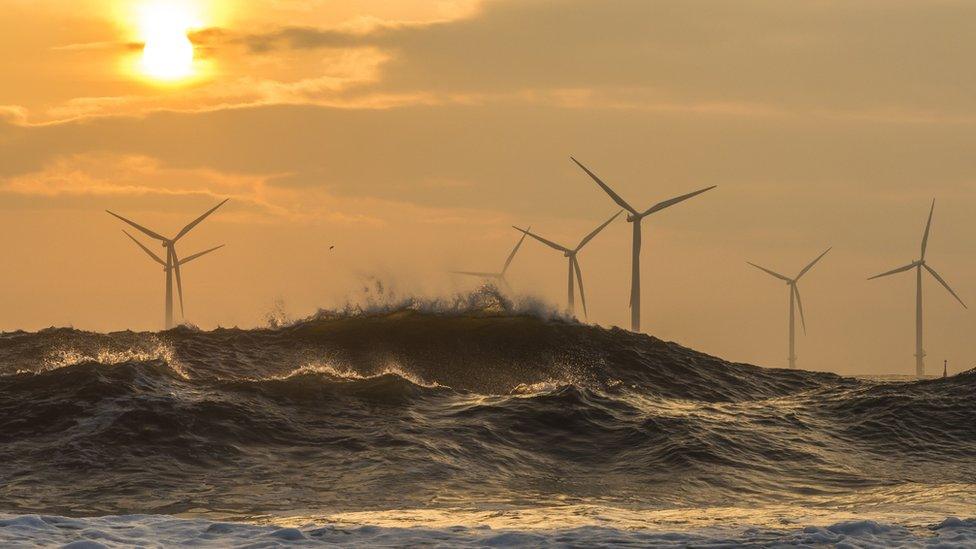Choppered: Downdraft for the offshore helicopter business
- Published
The offshore oil industry fuels demand for offshore helicopters, so the market booms and busts with the price
Even with many new offshore projects being approved for investment, a new report highlights too much capacity in the helicopter business
It forecasts growth and $18bn of revenue to 2023, but that is unlikely to keep the offshore workhorses busy

The revival of the oil industry has been come down the pipeline in sticky lumps, with the offshore sector taking longer than the onshore frackers to pick up the pace.
That shouldn't surprise. With the price per barrel up from the $30 basement to the mid-$70 range, the drilling and fracking of short-run wells in the back of America's beyond can be fired up with a small amount of robust drilling kit, on the back of a couple of trucks.
Similarly, if the price drops, the fracking klondykers can cap their wells and depart.
But with much higher costs to get in, and much less flexibility about bailing out, the offshore sector doesn't do wild swings from boom to bust and back - not like the ease of the guys in the Permian basin of Texas or the barren Bakken terrain of North Dakota. When investment decisions are in the billions, they have to be approached cautiously.
However, investment decisions for offshore have been getting green-lighted this year. The total value of offshore projects being approved has gone up 71 projects with a total value of $61bn to 124 projects this year, with a value of $96bn, according to Westwood, an oil industry consultancy.
The big growth is in Asia, with a third of this year's total. In Western Europe, the total value of projects, to be spent over many years, has fallen from $17bn to $11bn. You might think that kind of number is good news for the supply chain. And for much of the industry, it is.
Touchdown
But a new industry study suggests it's going to be much tougher to achieve sufficient profitable downdraft for the offshore helicopter business to achieve much of a lift-off.
Westwood, which analyses the industry from bases in Aberdeen, London, Houston and Singapore, reckons the global helicopter fleet is vastly over capacity.
Unlike rigs, which rust, lose their technical edge and eventually get scrapped if they're not being used, helicopters can be mothballed and rolled out for use, in tune with the industry's cycles over several decades. With fewer than 12 million passenger journeys per year, the offshore energy industry doesn't receive the same attention for emissions or noise that regulators have applied to cars and fixed-wing aircraft.
So some ageing relics of the early years in the North Sea are still at work. And the North Sea (or western Europe, as they see it at Westwood) dominates the global helicopter sector, with around 30% of activity.
The industry boom in the first half of this decade brought orders for a new generation of choppers, which touched down at the very point when offshore operators could no longer afford to fly so many of them.
Between 2015 and this year, there were 200 new medium and large helicopters delivered worldwide, says Westwood. Over the next two years, another 118 will be added.
"Like almost every other oil and gas asset-heavy market, there is an over-ordering of capacity in an upcycle and the lead-time of the units often means they are delivered when the market needs them the least," says this week's report.
Distorted markets
Now that they can afford to open up new frontiers, two factors are undermining the case for a helicopter revival. One is that there are fewer trips required offshore. Cost cutting has shifted most of the offshore workforce from two-week turnarounds to three-weeks rotas. Workers don't much like that, and nor do the helicopter operators.
The other is that fewer people are required to staff offshore installations. Much of what is happening west of Shetland is in gas developments, where the equipment is on the seabed and gas is piped to shore.
Oil needs more processing and attention before it can be piped much more than 10 miles. A lot more work has to be carried out on site than with gas, but it's being done more efficiently, and transferred onto tankers through loading facilities above the wellhead.

Steve Robertson, a director at Westwood who heads its oilfield services analysis, reckons the utilisation of the 1,900-strong offshore energy helicopter fleet around the world is now at around 56%.
"That low utilisation leads to low rates and very distorted markets," he says. "The market is very much out of equilibrium."
"This year, we've seen the market start to recover, but we're talking about 2% compound growth to 2023. It's a positive story, but not enough to soak up the excess capacity."
He estimates spend of $18bn worldwide up to 2023, but adds: "There is going to be distress in the supply chain for helicopters."
Heli-hoisting
Two further factors might mitigate these problems. One is that more offshore oil and gas fields are being developed off coastal Africa and South America. And the more the industry develops into deep water, the less attractive it is to supply them from ships, and the further helicopters are required to fly.
The other is that offshore wind energy is growing rapidly. Servicing these turbines often requires helicopters, sometimes to do precarious "heli-hoisting" when the brakes have been applied to the very large rotors. With 1,900 helicopters servicing oil and gas, there are so far only around 30 helicopters working in offshore wind.
That will grow. The distance from shore to turbine is rising rapidly, from an average 13km for projects starting in 2010, to 29km last year, and an estimated 71km in 2025. But even if helicopters could be go green on renewable fuel, wind energy is hardly likely to become a replacement source of business.